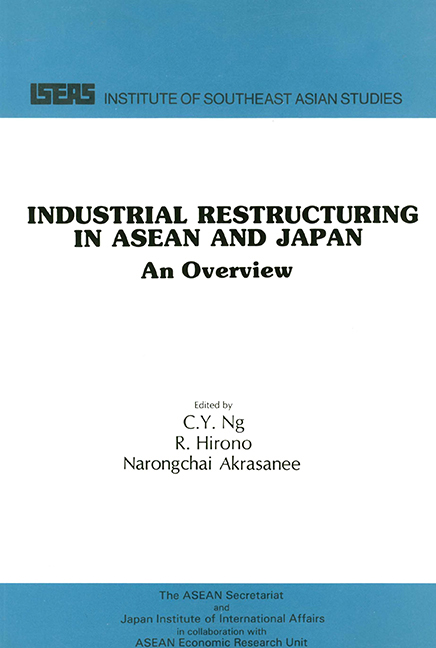Book contents
- Frontmatter
- Contents
- List of Tables
- Foreword
- Preface
- PART ONE ASEAN OVERVIEW
- PART TWO JAPAN OVERVIEW
- 1 JAPAN'S CHANGING INDUSTRIAL STRUCTURE: GROWTH AND DECLINING INDUSTRIES
- 2 CHANGING COMPARATIVE ADVANTAGES
- 3 CORPORATE RESPONSES TO INDUSTRIAL RESTRUCTURING AT HOME AND ABROAD
- 4 INDUSTRIAL RESTRUCTURING POLICY: DOMESTIC DIMENSIONS
- 5 RESTRUCTURING POLICY: INTERNATIONAL DIMENSIONS
- 6 CONCLUSIONS AND RECOMMENDATIONS
- THE EDITORS
2 - CHANGING COMPARATIVE ADVANTAGES
from PART TWO - JAPAN OVERVIEW
Published online by Cambridge University Press: 21 October 2015
- Frontmatter
- Contents
- List of Tables
- Foreword
- Preface
- PART ONE ASEAN OVERVIEW
- PART TWO JAPAN OVERVIEW
- 1 JAPAN'S CHANGING INDUSTRIAL STRUCTURE: GROWTH AND DECLINING INDUSTRIES
- 2 CHANGING COMPARATIVE ADVANTAGES
- 3 CORPORATE RESPONSES TO INDUSTRIAL RESTRUCTURING AT HOME AND ABROAD
- 4 INDUSTRIAL RESTRUCTURING POLICY: DOMESTIC DIMENSIONS
- 5 RESTRUCTURING POLICY: INTERNATIONAL DIMENSIONS
- 6 CONCLUSIONS AND RECOMMENDATIONS
- THE EDITORS
Summary
Foreign Trade and Economic Development
Japan's economy is often referred to as an “export-led economy”. The merchandise exports as a percentage of Japan's GDP, however, paint a different picture. According to the World Development Report 1986, the ratio for Japan was 15 per cent as of 1984, much lower than that for the United Kingdom, France, and West Germany, that is, 29 per cent, 25 per cent, and 31 per cent respectively. As for ASEAN member countries, the 1984 figure for Indonesia was 23 per cent, the Philippines 21 per cent, Thailand 24 per cent, Malaysia 56 per cent, and Singapore over 100 per cent. The fact that Japan's ratio has been relatively low may derive partly from its geographical and historical isolation. Moreover, since Japan's domestic market is so large with a sizeable population and a high per capita income, its dependence on the foreign markets to generate GDP is correspondingly lower. Perhaps for the same reason, the ratio for the United States has been low, registering only 8 per cent in 1983.
In the rapid growth period after World War II, the annual growth rate of Japan's export in real terms averaged 14.7 per cent during the 1965–73 period — slightly higher than the annual average growth rate of manufacturing production at 14.4 per cent, and much higher than that of GDP at 9.8 per cent. However, the contribution of the domestic demand to economic growth has consistently been larger than that of the export, as confirmed by several empirical studies.
Analysis on the Competitiveness of Manufactured Exports
Japan's Changing Trade Structure
The structure of Japan's foreign trade is dominated by the import of primary commodities and by the export of manufactured products. (See Table 2.1.) Manufactured exports as a percentage of the total merchandise exports have constituted more than 90 per cent during the last two decades. On the other hand, manufactured imports as a percentage of the total merchandise imports have been between 23 and 29 per cent.
- Type
- Chapter
- Information
- Industrial Restructuring in ASEAN and JapanAn Overview, pp. 67 - 76Publisher: ISEAS–Yusof Ishak InstitutePrint publication year: 1987

